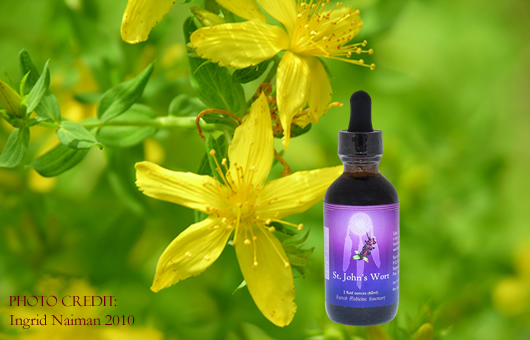
St. John's Wort got its common name
from the fact that the perennial flowers on or around St. John's
day, June 24th -- and its botanical name, Hypericum perforatum,
from Greek meaning "over an apparition," based on the
ancient belief that the herb was offensive to evil spirits . .
. who fled its odor. The yellow buds exude a burgundy-colored oil
when soaked in alcohol, hence the legend that the first plant emerged
from the blood that spilled when John the Baptist was beheaded
at the behest of Salome.
Clinically, St. John's wort is prized
as a nervine and antidepressant, so much so that in Germany, where
St. John's wort is approved for treatment of depression and anxiety,
it is prescribed 20 times more often than Prozac. Unlike many herbs,
St. John's wort has been extensively tested in clinical trials.
One trial in England involved 1757 patients with mild to moderately
severe depression. Dosages varied from 0.4 to 2.7 milligrams per
day. Most herbalists suggest that the herb be taken at least twice
a day.
Historically, St. John's wort was
used for a wide variety of conditions: any and all injuries to
the nervous system, especially nerve endings; dysentery, worms,
and diarrhea; jaundice and hemorrhages; incontinence and pulmonary
complaints involving congestion of the lungs. Externally, it has
been used as a fomentation for hard breast tumors and other conditions
involving caking of the breasts. Research indicates that hyperforin
has beneficial effects in treating depression, especially where
the patient is anxious, and hypericin is a superb antiviral agent,
offering a major hope to persons with enveloped viruses such as
herpes and HIV as well as hepatitis B & C. Most American producers
of standardized potencies are referring to hypericin whereas clinical
research in Austria and Germany strongly suggests that hyperforin
may actually be the more important "active ingredient" where
anxiety and depression are concerned.
Those familiar with my work know
I prefer using herbs and foods in their whole state. Nature loves
balance, and there is often a synergy between the different constituents
of an herb, one that may, for instance, relieve depression and
another that perhaps protects the body from injury due to excessive
use of an herb. Herbalists generally go one step further by complementing
the main herb with other herbs that work in harmony with the one
believed to be addressing the primary issue most directly.
Warning: Do not use
this herbal product in conjunction with conventional antidepressive
drugs. Some fair-skinned people experience increased photosensitivity
while taking St. John's wort. Avoidance of ultraviolet light is
recommended if such persons wish to continue the use of this herb.
For information on the side
effects of Prozac 
|





